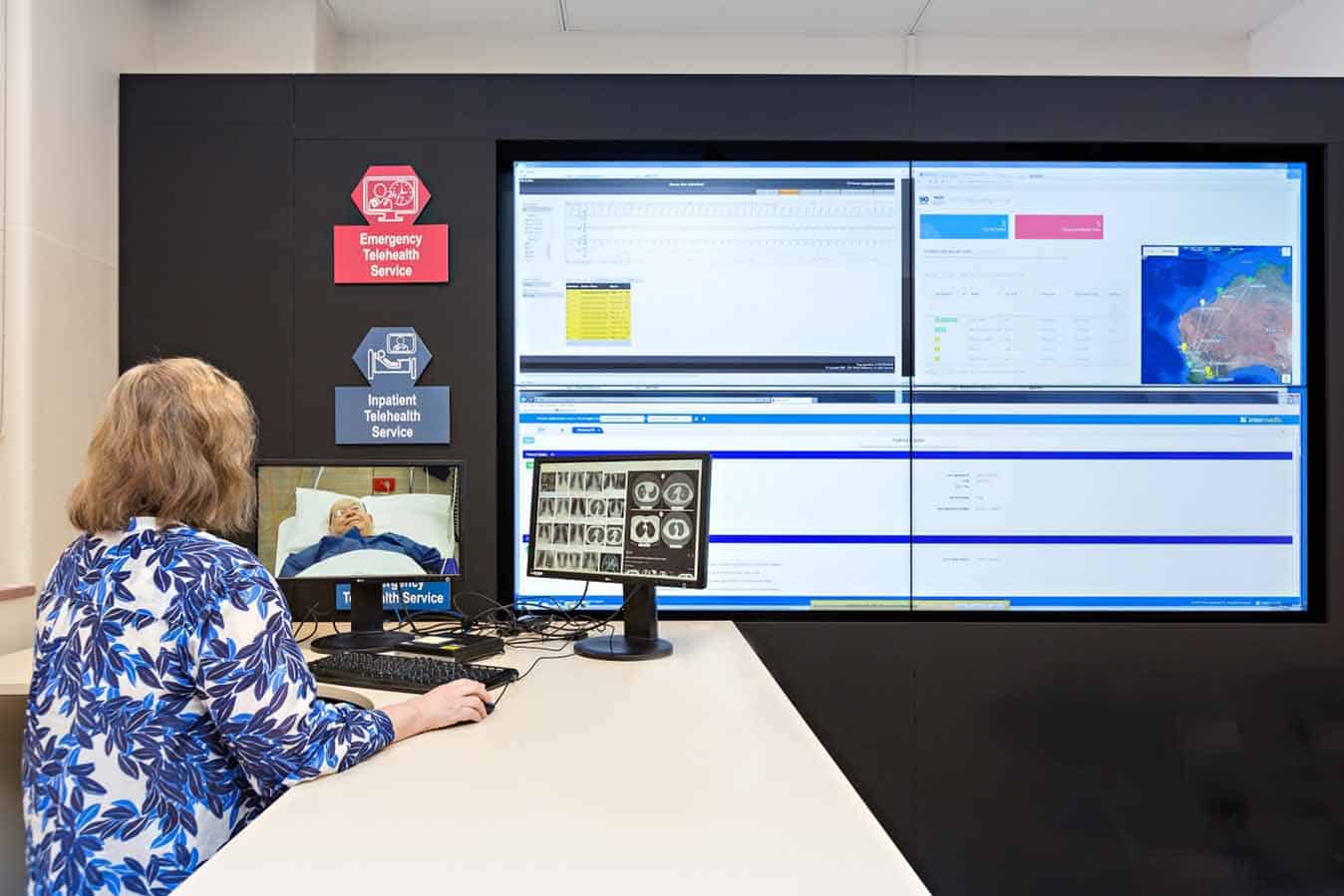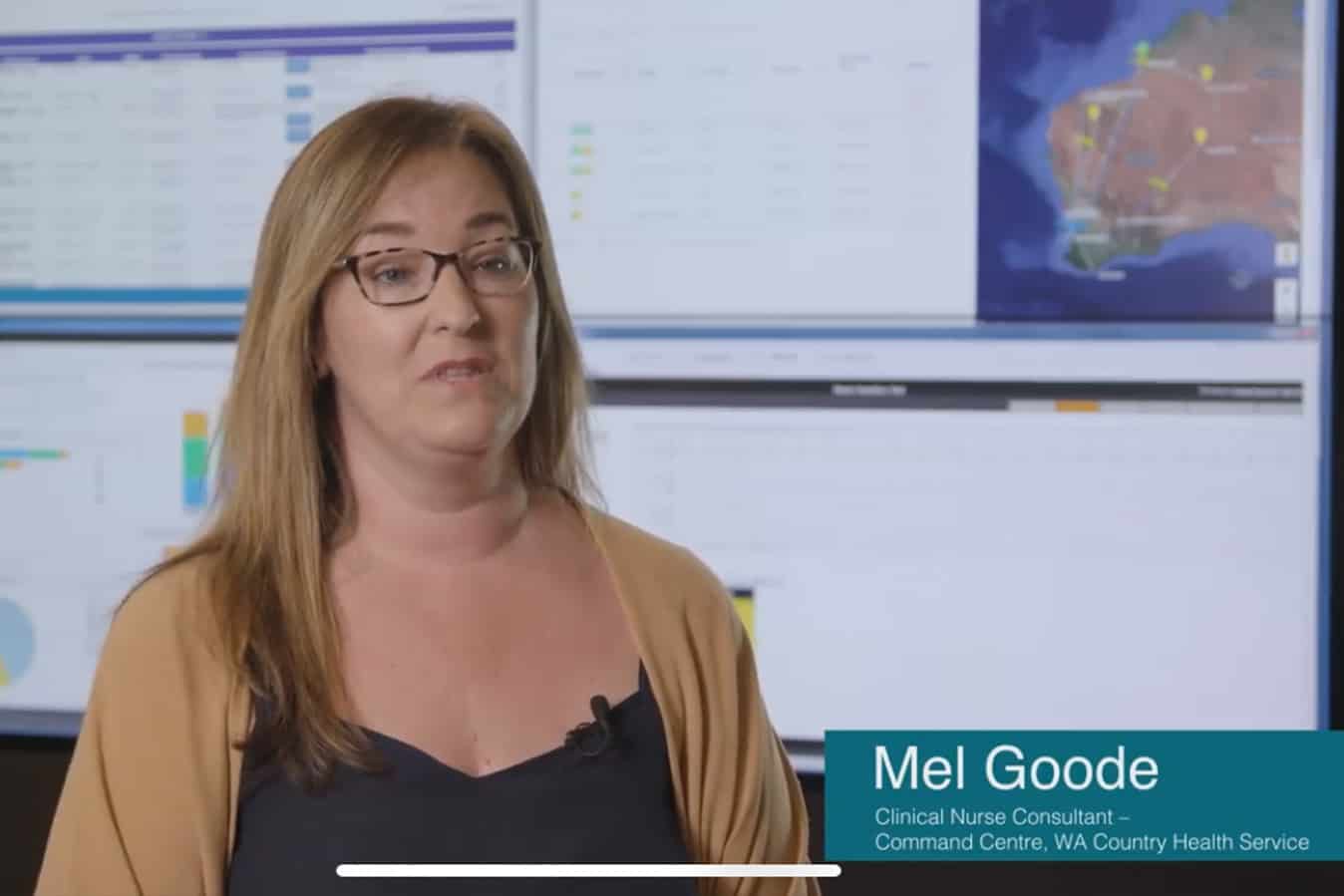Interested in telehealth nursing?
WA Country Health Service (WACHS) Command Centre Coordinator of Nursing and Midwifery Mel Goode shares her journey to telehealth with the ANMJ.
Emergency department (ED) nurse of 25 years, Mel Goode was UK-trained and working at the Charles Gairdner Hospital in Perth when her husband, a police officer was deployed to the Pilbara, in WA’s north-west.
“I unexpectedly found country nursing really rewarding and completely different from a tertiary emergency department. I found that having significant experience in ED nursing provided me with the skills for working in a small country hospital.
“Having been a jack of all trades, you have the ability to make hard decisions which is really important on a country site when you’re the only nurse. There is higher acuity but it’s less frequent, and the stakes are higher when it’s just yourself.”
Mel was working in Three Springs, north midlands WA, when emergency telehealth was introduced in 2015.
“Telehealth was an immediate game-changer, it removed that feeling of isolation working by yourself in the country. It was an eye-opener and transformative in terms of career aspirations for me. I had never been aware of telehealth, I had been a hands-on ED nurse.”
After four years of country nursing in various locations in remote WA, relocation back to Perth spurred Mel’s career move into the telehealth direction.
“I really didn’t want to go back to tertiary nursing in Perth. I contacted WACHS. There was emergency telehealth nurses in Perth supporting those in the country. I felt I understood the value of the service and that I had the ability to contribute with my experience.
“I had been on the other end of the camera, I had walked in their shoes, and had the empathy and understanding of the support they require. Nurses live and work in their communities with challenges such as limited resources and distances.”
The WACHS Command Centre offers services in a 24/7 virtual clinical hub. In August 2022 WACHS celebrated 10 years since the first patient in country WA accessed the Emergency Telehealth Service (ETS). The ETS has been embraced for its ability to bring a wide range of healthcare specialties to even the most remote areas.

“I didn’t have any nursing informatics experience. I had a really robust rural and remote and emergency nursing experience and country WA nursing – and I had a passion for it,” says Mel.
“One of the biggest learnings I had was to how to deliver my nursing skills in a different way, in a different modality. There’s not one book that teaches you how to do that. It’s understanding how you can work with that team to support them best. You can influence change. Telehealth empowers people.”
“It gives us the ability to support our country colleagues and patients where they are. Country patients are particularly invested in telehealth as it keeps them on country. It can support palliative care patients to remain close to their family, which is essential in this phase of their journey.
“If there’s a major trauma we can prepare the metro trauma team on how the patient will present or the RFDS – it helps everyone to be better prepared and retrieved as safely as possible. We are the eyes on the patient and make sure 100% that the patient is going to the right place, with the right crew. I think telehealth helps to close the circle that may previously have had gaps.
The challenges
Mel’s first resuscitation via telehealth involved a paediatric patient which introduced her to some of the challenges of telehealth.
“It was very emotive. I hung up the video conference and there was this emotional space. When you participate in a resuscitation in person there is a natural opportunity to process the events as a team, with those who were there with you, in the room. When you work via video conference, this is very different. Since then we have developed a robust debriefing process and encourage internal collective debriefing,” she says.
WACHS has a ‘Hot Debrief’ quick time out with a follow up a week or so later.
“It gives the clinical team an opportunity to talk about it with the broader collective. We’ve advocated for that as part of the team whether they be in Laverton, Kalgoorlie or Perth – that we are all part of the same team. St John’s Ambulance (officers), the police, they all come to debrief, its interagency and facilitated by the CNC. It takes the load off and supports staff in all our sites.”
Being dispersed geographically, the clinical team across different streams at WACHS huddle via video twice a day, am and pm.
“In telehealth we support people to learn new skills, when they are needed, and we take the cognitive load to enable people to do work of hands and hearts. It’s constantly evolving and is rewarding,” says Mel.
According to Mel, 5 key attributes of a telehealth nurse include:
- Excellent communication skills.
- Team player – you work independently but you collaborate with the wider team – ED, mental health, midwifery, palliative care, nurse practitioners, nurse educators, etc.
- IT savvy.
- Adaptable – you need to be able to pivot to whatever the need is.
- Able to troubleshoot. IT will always fail at some level. You need to be able to problem solve and know where and who can help you.
Working via video conferencing requires exceptional communication skills, says Mel.
“You rely heavily on verbal cues so you have to be really clear and concise and pick up on body language. You have to be more focused – you don’t have the senses of smell and touch so you need to get this information in a different way. Ask the question but more importantly hear the answer – and listen to what they’re not telling you!”
“You need to have significant and varied clinical skills and be quite experienced. It’s hard to deliver skills virtually if you do not have the clinical experience and rural and remote understanding. Having wide experience is invaluable.”
The opportunities and roles in telehealth are varied. Within WACHS, roles include for ED nurses, midwives, senior midwifery support providing remote CTG monitoring, mental health nurses, palliative care nurses, nurse and midwifery educators, chemotherapy nurses, OPD, burns, and wounds. In addition, there are roles for education and support for new graduates and transitioning nurses.
“The opportunities in telehealth are endless. This is a growing space to be in at the moment and there’s plenty of innovation.
“Be curious about what’s out there and how you can use your existing skills. Telehealth is not intended to replace the invaluable nurses and midwives living and working in rural and remote communities, the boots on the ground nursing, it’s an addition to existing services to improve the provision of care for patients and support for our colleagues. The boundaries are endless.”








